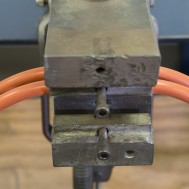When it comes to producing large o-rings, typical slash and glue methods don’t always cut it. As applications become more advanced, o-rings are required to withstand increasingly harsh environments. To produce stronger o-rings with tighter tolerances, the engineers at Apple Rubber developed a breakthrough manufacturing process known as Thermobonding.
Thermobonding, otherwise referred to as “spliced and vulcanized,” molds the seal joint with proprietary adhesives and cures with little to no mismatch, which generates excellent flexibility in large o-rings. To get a better understanding of the Thermobonding process, here’s a closer look at what you need to know.
Breaking Down the Process
Thermobonding is used for large o-rings that vary in size from 1 ½ inches in diameter to sizes large enough to wrap around a house. The process involves a two-part method of splicing and vulcanizing rubber to meet customer specifications:
- Molds are heated from 325℉ to 350℉ and rubber cord stock material is cut to match a specified size. These cuts are known as a splice. Non-cured adhesives are then applied to the ends of the cut cord stock
- A vulcanizer uses heat and pressure to cure and seal the cut ring. This will form an o-ring
When splicing rubber, the preferred cut angles are known as butt cuts or straight cuts. Cutting at a 45 degree angle creates more surface area, which can produce a better seal. If an o-ring diameter is too large, an engineer may have to perform a double splice. O-Rings of this size are commonly used in oil tank lids.
The Difference Between Cold Bonding and Thermobonding
Cold bondings differs from Thermobonding in that cold bonds do not require heat. Cold bonding uses adhesives such as Crazy Glue to form the o-ring, and unlike Thermobonding which utilizes vulcanization, the o-rings are simply left to dry naturally.
Cold bonding is often used as a quick fix to create an o-ring in a pinch, since this method does not provide as much flexibility as Thermobonding and is likely to present issues with fit. However, cold bonding may be the preferred choice when you want to avoid visible marks on your o-ring that may be produced by Thermobonding.
Quality Control in Thermobonding
Quality is always a critical factor when developing seals at Apple Rubber. We ensure that the Thermobonding process is screened for quality every step of the way. Our inspection process consists of:
- Full acceptance testing on all rubber cord before it’s used, including sampling for durometer, density, tensile, elongation and cross-section
- Complete part inspection after assembly for quality assurance, as well as measurements for inside diameter to ensure the o-ring size is exact
- Completed quality documentation, including statistical analysis, FMEA, PAPP, control plans and compliance to ASTM D2527
For more information about Thermobonding, contact an Apple Rubber engineer today.
